October 2020

Pass Labs XP-17 Phono Preamp & X250.8 Power Amp
Impressive sound quality that we’ve come to expect from Pass Labs.
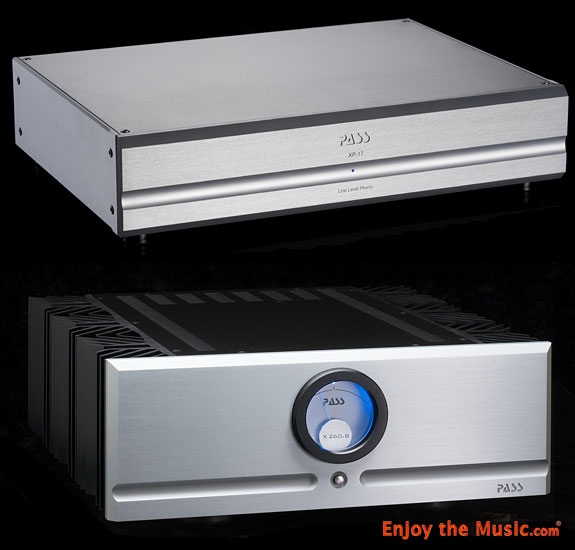
For quite some time I’ve been using a Pass Laboratories power amplifier, phono stage, and headphone amplifier as references in my listening room. There were times I thought that some might think I was a spokesperson for this brand of equipment! I could see how some might get that idea, because not only do I use three Pass Labs components in my system, I also will tell anyone who will listen that I consider Pass Laboratories’ high-end audio components the best in their respective price classes. Then again, those who have read my reviews of other brands of audio equipment will be able to tell that I approach each review with an open mind. I attempt to be as objective as possible, and other than the fact that I happen to have three Pass Labs components as references, I’ve never shown a hint of favoritism towards any component or brand of component in any of my reviews. It is quite obvious that I consider music more important than whatever audio equipment that might be in my system at the time.
A few months ago, I found out that I would be able to audition the Pass Laboratories XP-17 phono preamplifier and X250.8 power amplifier. I was quite excited about this since I relied so heavily on the great sonics of their older XP-15 phono preamp and X350.5 power amp. The newer X250.8 power amplifier has 100 Watts less power than the X350.5 I’ve been using for many years but is part of Pass Labs’ new “Point 8” series, and that is the amplifier that Pass had available for me at the time.
XP-17 Phono Preamplifier
I nearly forgot how long ago it was when I reviewed the Pass Laboratories XP-15 phono preamp. My rave review back in the spring of 2010 ended with the statement “I can’t remember the last time I wrote a review with no negative comments regarding the performance of a piece of equipment being scrutinized — there is always a nit to pick or two, but in the case of the Pass Laboratories XP-15 phono preamplifier, I can’t think of any negatives”. That’s quite a bit of praise for a phono preamplifier that cost $3800, has only one input, and has its loading and gain settings located on its back panel. However, in my review, I said that having only one input doesn’t matter much to an audiophile who uses a system with one turntable with one tonearm. Like I do. Having its settings on the back panel of the phono stage won’t matter much to someone who sets up their phono cartridge’s loading and gain settings and pretty much forgets about it until they replace their phono cartridge. Like I do.
Most importantly, though, and what I liked most about the XP-15 phono preamplifier was its sound. I wrote that the XP-15 possessed “an excellent transient response, natural portrayal of instrument textures, expansive yet appropriately scaled soundstage, tight and deep bass response, modern tube-like midrange qualities, glistening highs, solid bass, and excellent separation of instruments and sounds — did I leave anything out(?) — all without ever drawing attention to the gear that was performing the task, and fairly priced. I suppose that’s why the Pass Labs XP-15 was my reference phono preamplifier for such a long time.
Pass Labs XP-17
Pass Laboratories describes their newer phono preamplifier, the XP-17, as one that uses a shielded low-noise toroid and input filter module, like they do in their XP-12 linestage. The power supply has an extra stage of RC (resistor-capacitor) filtering. The XP-17 also has an all-new input circuit that is symmetrical and “lower in noise and distortion with greater drive capability”. Since Pass Labs claims that the THD+N (total harmonic distortion and noise) specification of a phono preamp is mostly made up of noise, by lowering the noise they improved the phono stage’s resolution and dynamics. The XP-17 is also designed with a split EQ network, as is used in their much more expensive XP-25 and XS phono preamplifiers. This is a network that is more accurate and can handle greater signal levels.
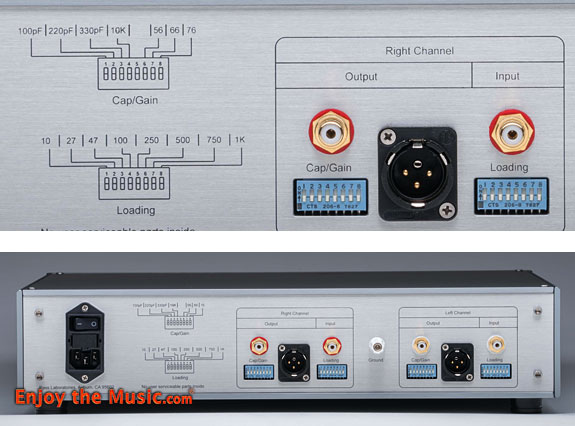
As with the XP-15, on the rear panel of the XP-17 has one pair of inputs, and “numerous” loading and gain options that will surely be able to handle just about any moving magnet (MM) or moving moil (MC) phono cartridge on the market.
Analog
There is no doubt that my system’s front-end gives me a leg up when it comes to reviewing a phono stage. What I call my “main system” is set up in a dedicated, acoustically treated listening room with a front-end that includes a Basis Debut V turntable, which was substantially upgraded by Basis Audio’s late A.J. Conti himself from an older model, a Debut Gold. Among the new model’s many upgrades, what I consider the most significant was switching out its DC motor and replacing it with an AC synchronous motor. This made it possible to connect the turntable’s power cord to an outboard speed controller.
With the motor now being fed by a perfect AC sine wave (from an AC regenerator, not Basis’s speed controller), its speed is now spot-on accurate because not only is it powered by this perfect sine wave, but a speed change is now performed not by moving its platter’s belt to a different position on the pulley, but by changing the speed controller’s frequency – 60 Hz for 33.3 rpm, and 81 Hz for 45 rpm.
Mounted on the Debut V’s armboard was the Tri-Planar 6 tonearm, which was built especially for me by Herb Papier, Tri-Planar’s former owner and manufacturer in his Wheaton, Maryland machine-shop shortly before he sold the company to its present owner, Tri Mai, in Minneapolis. The phono cartridge mounted on the tonearm was a Top Wing Suzaku “Red Sparrow”, as this $16,500 cartridge was graciously loaned to me by Believe High Fidelity for the review of the similarly priced Allnic H-7000 vacuum-tube phono preamplifier. I’ve been lucky enough to use this phono cartridge for other analog product reviews ever since.
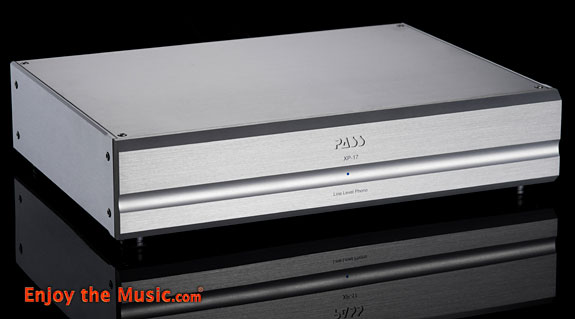
The linestage in the review system was the Nagra Classic Preamplifier, which is a vacuum-tube unit, yet I dare anyone to be able to tell how it is powered simply by listening to it. It is one of only a few that I’ve had in my system of late that I would consider very close to the proverbial “straight wire with gain”. If this linestage has any “sound” of its own, I suppose I could say that it will cool down the sound if there is an aggressive recording, because the tube preamp combined with the solid-state power amplifier, in this case, Pass Labs’ X250.8, is a perfect match for doing something like that, although, I can’t say that I’ve been able to pinpoint any of this type of “repair” in action.
The turntable’s speed control was an AC regenerator that has a front panel frequency control which enabled remote speed change. The linestage and phono preamplifier were powered not by the room’s dedicated AC lines, but by a battery power supply. The power amplifier had a separate, higher-powered battery power supply that was used when needed. Just about every interconnect, power, and digital cable in the review system was made by Kimber, their Carbon line is just about as transparent as one could ask for at a price that isn’t ridiculously expensive. Most of the audio gear for this review was loaded onto an Arcici Suspense equipment rack, the Pass Labs XP-17 on a shelf just below the linestage.
I powered the Pass Labs XP-17 not from one of the dedicated AC lines that run straight to the circuit box in our basement, or a power conditioner, but from a battery power supply, the Goal Zero Yeti 400 I wrote about at the beginning of last year. This enabled the Pass XP-17’s power cable to be connected to a power source with a pure, unadulterated, 60 Hz AC sine wave.
Newer
Even before it was fully broken in, it was obvious to me that I heard a dramatic improvement in sound from my analog front-end using the newer Pass Labs XP-17 phono preamplifier in my system. And even though it had many things in common with what I consider the “typical” Pass Labs sound, that being one that seems to take all the sonic advantages of a tube component mixed with the best traits of a solid-state, with the disadvantages of neither, it was different enough where I believe it if Pass told me that new phono preamp has a new circuit design rather than simply an improvement of the older one. Therefore, a side-by-side comparison would have been a worthless exercise.
The XP-17’s transient response was first-rate, but this phono preamp never sounded as if it was too analytical sounding That thought never entered my mind. It sounded like music. This lifelike portrayal of the instrument’s timbre was sometimes distracting, the same way it was distracting when every once in a while I would whip my head around as if being surprised by someone or something entering the room, except this sound had emanated from the far left or right side of the soundstage.
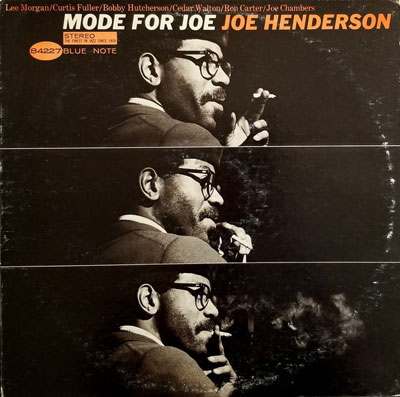
As a result of these lifelike sonic textures, in my listening notes, I described Joe Henderson’s tenor sax as recorded by Rudy Van Gelder on the 1966 Blue Note LP Mode For Joe as not sounding like a tenor sax, but a tenor sax. All the instruments on the album sounded almost as scary-real as some of the best phono preamps I’ve ever had in my system. This attribute was noticeable not only on Henderson’s sax but also on Lee Morgan’s trumpet and Curtis Fuller’s trombone. Yes, this album has quite a stellar line-up, with Cedar Walton on piano and Bobby Hutchinson on vibes. The rhythm section wasn’t too shabby either, with Ron Carter on bass and Joe Chambers on drums.
Some listeners aren’t in love with the way engineer Rudy Van Gelder pans the lead instruments to one speaker, and so if possible, they often opt for the monaural version of many Blue Note titles. I like Van Gelder’s methods, especially when I can hear the bleed from one instrument into the other speaker. This effect is much more noticeable when using decent, or more than decent analog components. The Pass Labs XP-17 is much more than simply a decent component.

As I mentioned, XP-17’s soundstage was incredible — expansive yet appropriately scaled when the recording was up to par, so when playing the Speakers Corner reissue of Dvorak’s Symphony No. 9 (From the New World), I would close my eyes, and even though the large orchestra wasn’t nearly as large as the real thing, it was a blast enjoying the sound of a large orchestra with everything in its “correct” place, and sonically drawn to scale. This Decca LP was recorded in 1961, and although I don’t think I’d enjoy living in that era, the orchestra featured on this recording is the Vienna Philharmonic Orchestra, and the conductor, István Kertész. Imagine how lucky I was to hear this orchestra play this piece in concert a while ago, and being able to show up wearing jeans and a black rock band t-shirt, with my date, a woman of color! I don’t think that would have been too cool at a VPO concert in 1961.
What was cool was hearing the VPO’s cello and viola section’s warmth and detail in a live setting. My sonic memory of that evening’s performance is etched into my brain and had many important qualities that were in common with what I heard on this recording when playing it with the Pass XP-17 in my system. It seemed as if this was made possible because of this phono preamplifier’s skill in reproducing the signal that it received from the phono cartridge, somehow “knowing” what instrument or instruments it is sending along to the linestage. Yes, that’s a rather obtuse way of describing what I heard, but there isn’t much more to say when one can’t find much fault with the sound quality of a component.
In the recent past, I’ve heard this wonderful Dvorak album through other phono preamps, too. The more esoteric (and expensive) phono preamps delivered to my linestage, and eventually my speakers, better sound. But, the Pass Labs XP-17 has nothing to be ashamed of, even when compared to, for example, the Allnic phono stage that I drooled over when I reviewed it at the end of last year, or the even, believe it or not, the much more expensive Dan D’Agostinao Master Audio Systems Momentum phono preamplifier. Both of these are much better than the Pass phono preamp I was auditioning in many, many ways. If I had the choice, I’d opt for using either of these phono preamps as my reference without a second thought. I am an audiophile, after all. But it was an honor having the opportunity to have them in my system at least for the length of the review period.
However, when playing records using the XP-17, the gestalt of what made my favorite records sound so good was still there, many of the same traits that make these more expensive phono preamps sound so good, and on the other side of the spectrum, makes analog playback the playback medium of choice for audiophiles the world over these days, was still there with the Pass XP-17. More so than any other phono preamplifier I’ve heard anywhere near its price, which makes the Pass XP-17 at $4300 a steal. The XP-17 made it easier to forget about the more costly phono preamps and others that have been in my system of late, and enjoy the hell out of listening to records with the Pass Labs XP-17 in my system.
Low Frequencies
The XP-17 reproduced low frequencies seemingly without limit and was also very tight sounding and pitch specific. When I was listening to some of the sides of Kraftwerk’s four-LP vinyl box set Minimum / Maximum, the recordings of its 2004 world tour, on the track “The Robots” on side 7, at the beginning of the song there is a bass synthesizer playing what could be called the melody of the song. Then, when the first verse starts, a different bass-synth sound comes in on top of the other bass synth sound. Both are not only clearly heard, but heard as two very distinct sounds that Kraftwerk probably took months perfecting. With the volume on the amplifier high enough, the bass sounds and synth bass drum did not only shake the frames of the windows on either side of my medium-sized room but could also be felt in my gut!
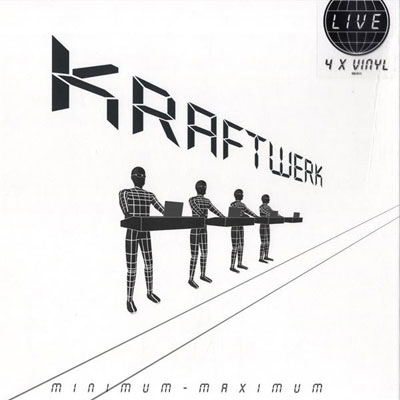
The midrange of the XP-17 has what I like to call modern tube-like midrange qualities, but with the transparency that comes from the best solid-state phono preamps. In other words, all the sounds with lots of midrange energy, in other words, 90% of the sounds that passed through this phono preamp, were not only super-realistic sounding, but also possessed enough dynamic distance between all of the sounds for me to be able to believe that I was hearing a direct connection to the signal it was “reading” from the phono cartridge, and at the same time, had enough of an organic quality to somehow let me in on the intentions of the musicians and those who made the recording.
Add all the above to the Pass XP-17’s glistening highs, and excellent separation of instruments and sounds made this a phono preamplifier that made me want to listen to record after record and did this all without ever drawing attention to the gear that was performing the task. It also helped that the Pass XP-17’s background noise was practically non-existent. Without the phono cartridge cables connected, I could not tell whether this phono stage was connected to the linestage or not, made it so I could easily give this phono preamplifier one of the best compliments I could give a component — I would forget it was there.
Reference
There was never any question that as soon as I became accustomed to the sound, or lack thereof, of the Pass Labs XP-17, it would become my new reference. Even though the user of this phono preamp must live with its loading and gain controls on its rear panel, and the phono preamp is limited to only one input (which are the only negatives I can think of when considering this phono preamp), it is quite an amazing feat that after ten years of research and development the price of this new phono stage was only increased by $500. Recommended? Of course.
Pass Labs X250.8 Power Amplifier
I usually connect with audio manufacturers by email. But I’ve also spoken on the phone every once in a while to the nice people at Pass Laboratories out in Auburn, California. Auburn is located in a beautiful part of Northern California foothills in the Sierra Nevada mountain range, about 30 miles northeast of Sacramento. I can only imagine how picturesque that setting is. Maybe that is one of the reasons why everyone who I speak with at Pass Labs is always in such a good mood.
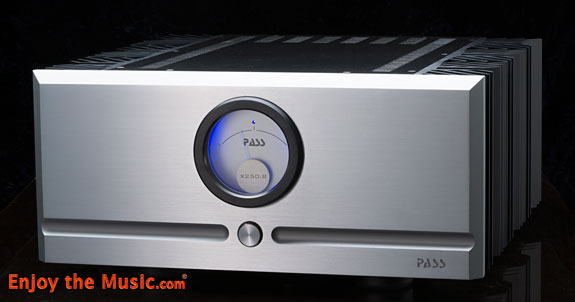
I was skeptical. I assumed that a 250 Watt amplifier wouldn’t have enough power to drive my reference Sound Labs Majestic 545 full-range electrostatic speakers, which I always assumed needed more power than this because of their impedance rating, which is very challenging when the volume is set to what I consider “normal’ listening levels. Pass Labs told me that they were familiar with the speakers I was using and reassured me that 250 Watts would be plenty of power. I wouldn’t notice much difference as far as the volume setting was concerned, that it would be very similar to the 350 watts per channel Pass Labs X350.5 that I’ve been using over the past so many years. I reviewed the older X350.5 power amplifier in Enjoy the Music.com back in July 2012, and it served as my reference ever since.
In addition to having more than enough power to drive my speakers, Pass Labs also told me that they were confident I would hear a major improvement in sound quality with the new power amplifier. This was because the X250.8 had been “painstakingly designed, tweaked, redesigned, and fine-tuned” by Pass Labs. Spoiler alert: Not only was 250 Watts per channel plenty of power to drive the Sound Labs electrostats, but I did hear a major improvement in sound quality with the newer power amplifier.
System
I reviewed the Pass Labs X250.8 in the same system as the XP-17 phono preamplifier was reviewed, but in addition to the analog front-end, I also used digital sources when assessing the performance of the power amplifier. The digital front-end consisted of a computer-based music server, with its USB output connected to an EMM Labs DA2 digital converter. I also played a few 5″ silver discs, usually SACDs, and listened to at least a couple of Blu-ray discs on an Oppo UDP-203 4K Ultra-HD Blu-ray/universal disc player. The 19″ wide, 21.25″ deep, and 9″ high, 100 pound Pass Labs X250.8 power amplifier sat on the lowest shelf of the Arcici equipment rack.
Despite what I was told by Pass Labs before I connected the X250.8 to my system, I was expecting the X250.8 to sound better than my old Pass Labs amp, primarily because I thought about how Pass Labs it had been more than eight years since the older version of this amplifier had entered the market, which means that they had about that much time to develop the new Point 8 series of their “X” Class A/B power amplifiers. What I liked about the older Pass Labs amp that had been in my system, besides being rather brutish at 350 Wpc, was its tight grip on the seemingly bottomless low-frequency response, extremely transparent midrange, and lifelike treble reproduction. And so, I figured that the newer X250.8 would sound similar to the older Pass Labs amp, only better. Yes, it did sound better. But not in the ways I was expecting. I was very surprised when first started listening, as it seemed as if the only thing that the sound quality of the new amp had in common with the older amp was it was made by Pass Labs and its model number seemed similar.
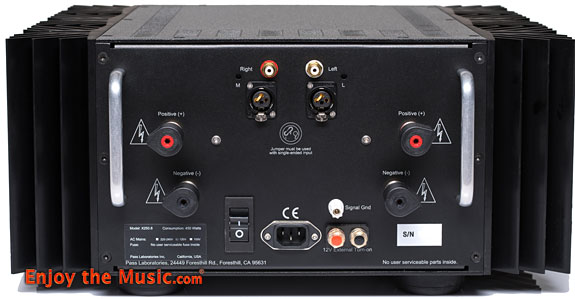
I thought that it was obvious that Pass Labs went back to the preverbal drawing board with this component. My mind’s ear quickly became accustomed to the sound of the new X250.8.
Compared to the older Pass Labs power amplifier, I imagined that the sound of the X250.8 power amplifier was a reflection of the fact that the designers upgraded the “brain” of the amplifier. It was able to somehow magically “hear” a musical signal, know what instrument was being reproduced, somehow knowing, the intentions of the musicians who played this music, and somehow knowing what the intentions of the engineers who recorded it were and delivered this signal to the speakers without amending it in any way other than seriously increasing its volume.
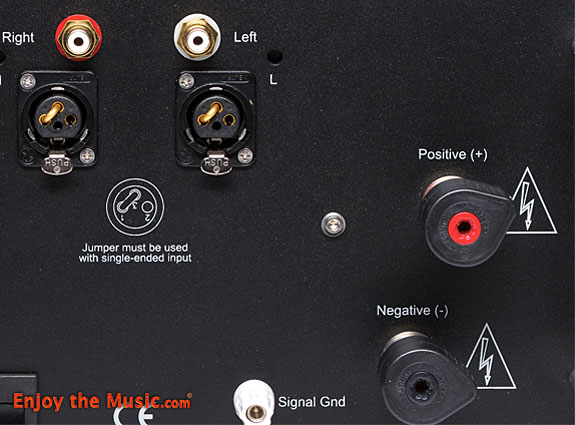
I was just kidding; I did not believe that the X250.8 used any magic to perform as it did in my system. But it certainly sounded that way. Most likely, the skilled designers at Pass Labs carefully engineered the circuits of this amplifier to do so. In my reference system, In addition to the Sound Labs Majestic 545 speakers, I heard evidence of its amazing sonic magic also with the amazing Raidho TD4.2 that I reviewed in July of this year. The Sound Labs are excellent speakers. But the Raidho speakers, which not only cost about nine times as much as the Sound Labs speakers, were also objectively better. This was patently true, even though, surprisingly, the Sound Labs reproduced some upper midrange sounds, especially percussion instruments, more realistically than the Raidho. They are electrostatic speakers, after all. But still, the Raidho outclasses the Sound Lab in many other areas, and they will surely receive an Enjoy the Music.com Blue Note Award in 2021.
The review system also included a pair of SVSound SB16-Ultra subwoofers, which I usually use to fill in the lowest of the low frequencies, especially when using speakers such as the Sound Labs, as they are specified to go as low as 35Hz. The Raidho speakers’ low-frequency response is specified to reach about 10 Hz lower than the Sound Labs and made the job of the subwoofers much easier, and therefore were hardly used at all. I’m not going into as much detail of the sound quality of the Pass X250.8 as I did with the XP-17 phono preamplifier, because when the X250.8 was first released to the public, Anthony Nicosia reviewed it in the pages of Enjoy the Music.com, and therefore I strongly suggest one read it if one wishes to get a full description of this wonderful amplifier’s sound.
Still, I would describe this hefty power amplifier as extremely muscular sounding, comparable to an iron fist in a silk glove latching onto the sound with a tight grip on the bass, and also having this tight control on the music throughout the frequency spectrum. Yet it never impaired the important cues that could distort the emotion of the musical signal it was amplifying I had absolutely no problem imagining the power amp passing onto the speakers exactly what it heard coming from the Nagra Classic Preamp, but also, as I said above, somehow “knowing” what sound it was reproducing, and therefore was able to transfer this sound onto the speakers exactly what it heard from the linestage, and having this gentle giant pass the signal onto the speakers.
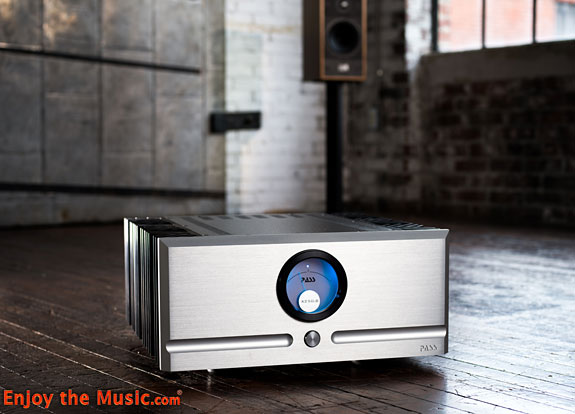
Expect Excellence
At the X250.8’s justifiable asking price of $10,000, one would expect this component to at least look the part. Weighing in at around 100 pounds, with its rather thick aluminum faceplate and recognizable round, illuminated blue central power meter, this power amplifier looks as good as it sounds. The cosmetics of the XP-17 phono preamplifier are more understated. Even though the phono preamplifier isn’t nearly as large or heavy as the X250.8 power amp, and it doesn’t have a large, lighted meter on its front panel, it still retains the classic Pass Laboratories attractive cosmetics with its aluminum cabinet and subtle, alluring blue LED in the bottom center of its thick faceplate.
Neither the Pass XP-17 nor X.250.8 power amplifier is “perfect”. There are plenty of components that are better than they are. Even Pass Labs manufacturers better-sounding components, but I’m convinced that an audiophile is going to have to spend much more money to get a “better” sounding phono preamplifier or power amplifier. If I can manage it, these two high-end Pass Laboratories audio components aren’t going anywhere. I recommend both if looking for a power amplifier or phono preamp anywhere near either of their prices. If you audition them, it is very likely you’ll welcome them into your system, too.
| XP-17 | X250.8 | |
| Tonality |  |  |
| Sub–bass (10Hz – 60Hz) |  |  |
| Mid–bass (80Hz – 200Hz) |  |  |
| Midrange (200Hz – 3,000Hz) |  |  |
| High Frequencies (3,000Hz On Up) |  |  |
| Attack |  |  |
| Decay |  |  |
| Inner Resolution |  |  |
| Soundscape Width Front |  |  |
| Soundscape Width Rear |  |  |
| Soundscape Depth |  |  |
| Soundscape Extension Into Room |  |  |
| Imaging |  |  |
| Fit And Finish |  |  |
| Self Noise |  |  |
| Value For The Money |  |  |

Check out Enjoy the Music!
See many great reviews by Enjoy the Music.com at this link.
Specifications
Pass Labs XP-17 Phono Preamplifier
Gain: 76, 66, and 56dB balanced XLR, 70, 60, and 50 unbalanced RCA
RIAA Response: 20Hz to 20kHz (+/-0.1dB)
Distortion 0.004%
Output Impedance: 110 Ohms SE, 220 Ohms Balanced
Input Impedance: 10 to 47kOhms / 10 to 750 pF
Dimensions: 17″ x 12″ x 4″ (WxDxH)
Weight: 19 lbs.
Warranty: Transferable, limited three-year warranty
Price: $4300
Pass Labs X250.8 Power Amplifier
Type: Solid-state stereo amplifier
Frequency Response: 1.5Hz to 100kHz
Gain: 26dB @ 2.2V input
Operating Class: AB
Power Output: 250 Wpc @ 8 Ohms and 500 Wpc @ 4 Ohms
Leaves Class A @ 16 Watts
Distortion (1 kHz, full power): 1%
Maximum Output: 80 Volts and 28 Amperes
Input Impedance: 50 kOhms unbalanced RCA, 100 kOhms balanced XLR
Damping Factor: 150
Slew Rate (V/uS): 50
Output Noise (uV): 200
Input CMRR (dB): -60
DC Offset (V): 0.05
Dimension: 19″ x 21.25″ x 9″ (WxDxH)
Weight: 95 lbs.
Warranty: Transferable, limited three-year warranty
Price: $10,000
Company Information
Paragraph
CoiPass Laboratories
13395 New Airport Road
Suite G
Auburn, CA 95602
Voice: (530) 878-5350
Fax: (530) 878-5358
Website: www.PassLabs.com















Want to join discussion?
Feel free to contribute!